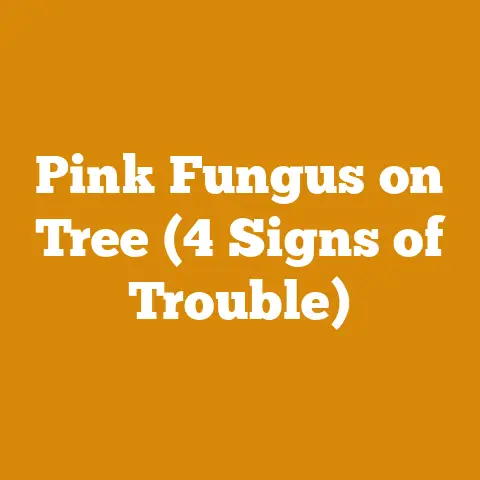Chip Drop Locations (3 Ways to Find Free Chips)
Every year, the U.S. produces an estimated 20 million tons of wood chips. Just think about the possibilities with such a vast amount of potential mulch, compost, and landscaping material at your fingertips. If you’re eager to get your hands on some of these wood chips for free, you’re in for a treat. I’m going to walk you through three effective methods for finding free wood chips, sharing personal stories, insights, and all the nitty-gritty details you need along the way.
My First Experience with Chip Drops
I’ll never forget the thrill of my first successful chip drop. The anticipation was palpable as I waited for that truckload of fresh wood chips to arrive. When it finally did, I felt a sense of satisfaction knowing I was not only saving money but also contributing to a more sustainable practice. So, how did I make it happen? Let’s break it down together.
1. Local Tree Services
One of the simplest ways to find free wood chips is by reaching out to local tree services. These companies often have an abundance of chipped material from their daily operations, and they’re usually more than willing to part with it.
Steps to Connect with Local Tree Services
- Research and List: Start by compiling a list of all the tree services in your area. A quick online search or a drive around your neighborhood should help you get started. Personally, I found that visiting local garden centers and asking for recommendations was an effective way to discover reputable companies.
- Make Contact: Once you have your list, it’s time to reach out. Give them a call or drop them an email asking if they have any excess wood chips they’d like to get rid of. Be courteous and direct—remember, these folks are often quite busy.
- Provide Details: If they have chips available, let them know where you live and any specific requirements you have. For instance, you might want smaller chips for mulching flower beds or larger ones for pathways.
- Schedule a Drop-Off: Once you’ve made arrangements, schedule a convenient time for the drop-off. Many tree services will deliver for free within a certain radius, which is a fantastic deal.
Safety Precautions
- Clarify Contents: Always ask about the types of trees in the chips to avoid any harmful species like black walnut that can be detrimental to plants.
- Check Local Regulations: Ensure that your local ordinances allow for such deliveries at your residence.
Story Time
I once contacted a local arborist who was thrilled to have someone take away his excess wood chips. He delivered a massive pile to my driveway, and we ended up chatting about different types of trees and their uses in landscaping. It was an eye-opening experience that deepened my appreciation for arboriculture.
2. Community Online Platforms
Platforms such as Craigslist, Facebook Marketplace, and local gardening forums are treasure troves for finding free wood chips.
How to Use Online Platforms
- Search Regularly: Make it a habit to check these platforms regularly because listings can pop up and disappear quickly. I set aside some time each morning with my coffee to browse new offers—it’s become part of my routine.
- Set Alerts: Use notification features for keywords like “free wood chips” or “free mulch” so you can be among the first to know when something comes up.
- Post a Request: Don’t hesitate to post your own ad requesting wood chips. Many people are eager to give away excess materials, especially if it helps clear their space.
Tips for Success
- Be Responsive: Respond quickly to offers as there might be others interested too.
- Verify Source: Make sure the source is reliable to avoid unwanted surprises like chipped pressure-treated wood.
Personal Insight
I once posted an ad on Facebook Marketplace looking for wood chips and was amazed at the response I got from local gardeners who were more than happy to share their surplus. That experience taught me the value of community connections and how they can lead to mutually beneficial exchanges.
3. Municipal and Recycling Centers
Many cities offer free wood chips at municipal collection sites or recycling centers, making them excellent resources for gardeners and landscapers alike.
Finding Municipal Chip Drops
- Check City Website: Begin by exploring your city’s official website for information regarding free chip drop locations and availability. Sometimes this information is tucked away in sections about waste management or public works.
- Visit in Person: If online searches yield no results, take a trip down to your local recycling center or municipal yard to see what they have available.
- Bring Your Own Bags/Containers: Some centers require you to load and transport the chips yourself, so come prepared with sturdy bags or containers.
Important Considerations
- Variety in Quality: Be aware that the quality and size of chips can vary widely depending on the source.
- Availability Fluctuates: These centers can run out quickly, so it’s wise to check back frequently or call ahead.
A Memorable Visit
On one occasion, I visited my local recycling center expecting just a small amount of wood chips but was greeted by a mountain of them! I ended up spending the better part of my afternoon loading up my truck—talk about a workout! It was well worth it when I saw the transformation in my garden beds.
My Personal Takeaways
After using these methods over time, I’ve learned that a combination of them maximizes your chances of success. Flexibility is key—you never know when an opportunity will arise!
Equipment Requirements and Prerequisite Knowledge
Before embarking on your quest for free wood chips, there are some essential tools and knowledge you should have:
Equipment You’ll Need
- Shovel/Rake: Useful for spreading the chips evenly across surfaces.
- Wheelbarrow: Ideal for transporting larger quantities from drop-off points.
- Tarp: Handy for covering chips during transport or storage.
- Work Gloves: Protect your hands from splinters and rough materials.
- Buckets/Containers: For collecting smaller loads if you’re visiting collection sites.
Prerequisite Knowledge
- Identify Tree Types: Understanding which trees produce suitable chips is crucial for avoiding harmful varieties.
- Basic Landscaping Skills: Knowing how to effectively use wood chips in your garden or landscape will ensure optimal results.
- Local Regulations: Familiarize yourself with any local guidelines regarding chip use and storage.
Insightful Anecdote
During my early days of collecting wood chips, I underestimated the importance of having proper equipment. There was one time when I showed up at a municipal site without gloves or containers—it was a rookie mistake! After that experience, I always double-check my gear before heading out.
Troubleshooting Tips and Best Practices
- Avoid Pest-Prone Wood: Exercise caution with softwoods like pine that might attract pests.
- Watch for Contaminants: Be vigilant about ensuring no treated or painted wood is included in your chips.
- Storage Solutions: Properly store excess chips to prevent mold and rot—consider using breathable bags or bins that allow air circulation.
Troubleshooting Example
Once, I collected a batch of wood chips only to realize they had been contaminated with treated lumber remnants. It was a lesson in thorough inspection—I now make it a point to examine every load closely before bringing it home.
FAQs
What if I can’t find any free wood chips in my area?
Try broadening your search area or ask fellow gardeners and landscapers if they have any leads. Networking can open doors you hadn’t considered.
Are there types of wood chips I should avoid?
Yes, steer clear of black walnut and eucalyptus as they can be toxic to certain plants.
How do I know if the wood chips contain chemicals?
Always inquire about the origin of the wood from your source to ensure it’s untreated.
Can I use fresh wood chips right away?
It’s recommended to let fresh chips age for several weeks before using them directly in garden beds as mulch.
How do I prevent mold in stored wood chips?
Ensure proper airflow by storing them in breathable containers and keeping them dry.
Remember that patience and persistence pay off when hunting for free wood chips—and don’t forget to enjoy the process! Happy mulching!






